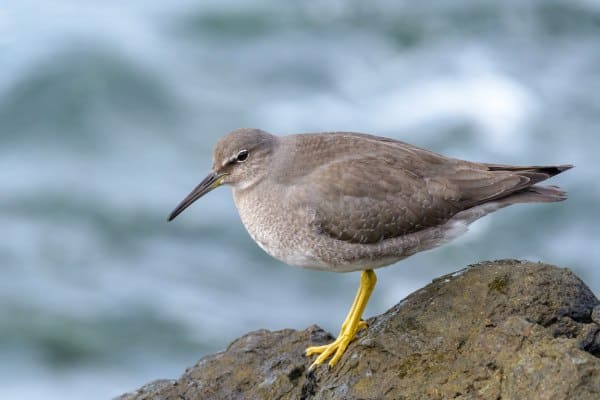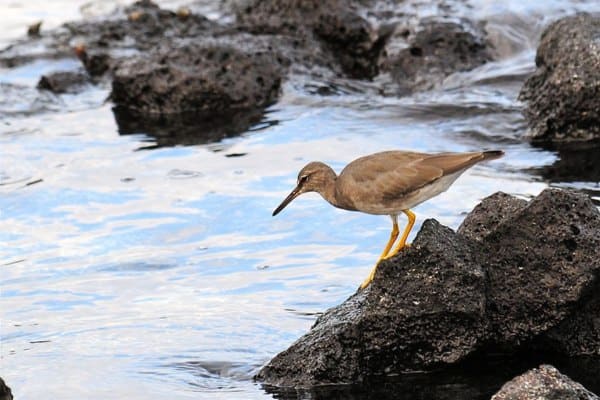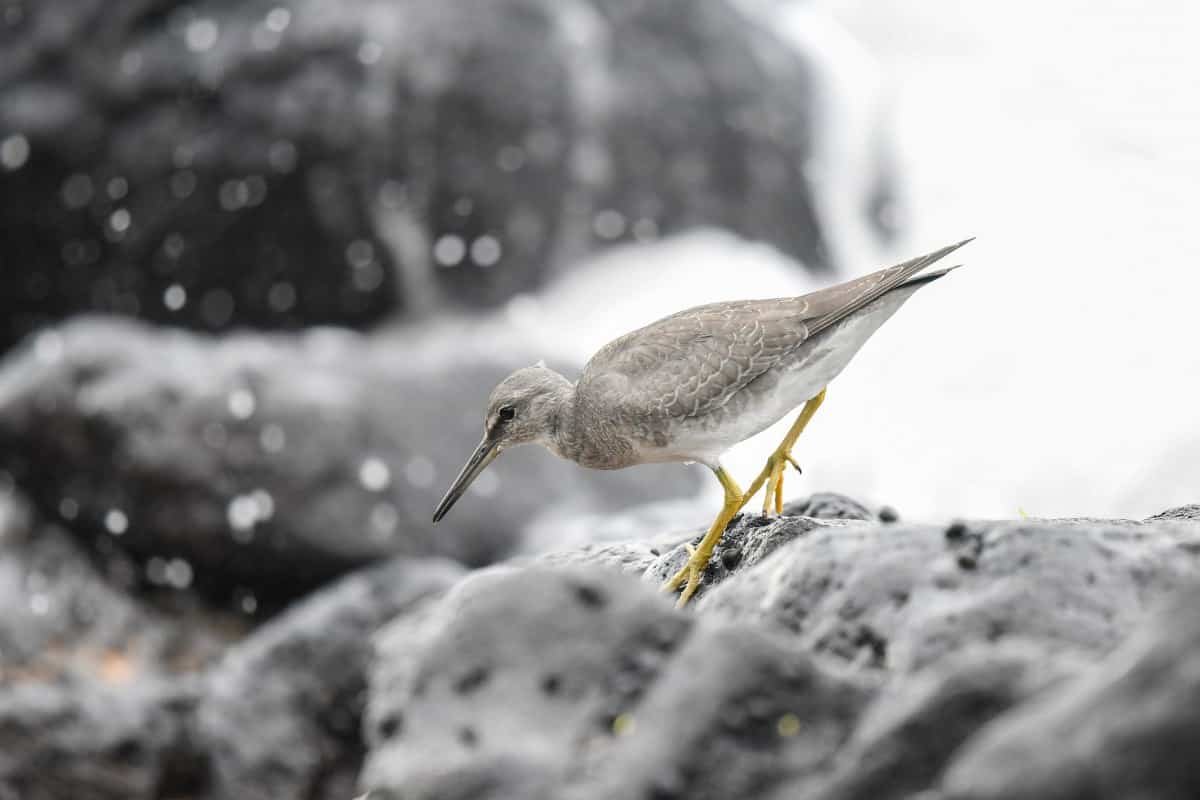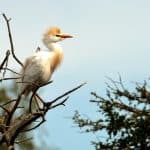Wandering tattler on coastal rocks | image by Wandering Tattler via Flickr | CC BY-SA 2.0
Common Name: Wandering Tattler
Scientific Name: (Tringa incana)| Size | Diet | Range in Hawaii | Status in Hawaii |
|---|---|---|---|
| 9 in. - 10 in. | small crabs, shrimp, mollusks, and aquatic insects | Kaua'i, O'ahu, Maui, Moloka'i, Lana'i, and Big Island | Least Concern |
Meet the Wandering Tattler, scientifically known as Tringa incana – a captivating medium-sized shorebird found along the scenic Pacific Rim, from Alaska to Hawaii. Despite not being native to Hawaii, these charming birds grace the islands with their presence during their non-breeding season. Known for their distinctive appearance and intriguing behavior, the Wandering Tattler has piqued the curiosity of bird enthusiasts worldwide.
Join us as we delve into the enchanting world of the Wandering Tattler, exploring its unique traits and its regular sojourns in the beautiful landscapes of Hawaii.”
Wandering Tattler
Appearance

The Wandering Tattler is a striking shorebird known for its distinctive appearance. These elegant birds measure approximately 9 to 10 inches (23 to 25 centimeters) in length. They have sleek, slender bodies with long, slightly curved bills that they use to probe for food in the sand and mud.
One of their standout features is their striking plumage, characterized by a black-spotted, white underbelly that contrasts beautifully with their grayish-brown upperparts. During the breeding season, their plumage becomes even more captivating, with intricate patterns and colors that adorn their neck and chest.
Diet
The diet of the Wandering Tattler is as fascinating as its name suggests! These shorebirds are skilled foragers, specializing in a delectable menu of aquatic delicacies. Their dining preferences include a variety of delectable morsels such as small crabs, shrimp, mollusks, and aquatic insects.
Nesting

These agile avians choose rugged and remote locations for their nests, typically in rocky crevices or on cliffs close to freshwater sources. Their nest is a simple, unadorned affair, often just a scrape in the ground lined with pebbles, twigs, and bits of vegetation.
What’s truly fascinating is their migratory journey to these nesting sites. Wandering Tattlers breed in far-flung, northern regions, including northeastern Siberia and Yukon, Canada. After journeying thousands of miles, they arrive at these secluded nesting locations in the spring.
During this time, the tattlers become diligent parents, carefully guarding their eggs and later, their chicks. They employ stealth and distraction techniques to deter predators and ensure the safety of their young. Once the chicks hatch, they are precocious and can feed themselves shortly after birth, a testament to the bird’s resilience and adaptability.
Behavior
Wandering Tattlers are agile hunters, using their long, slender bills to expertly probe for food. They have a keen eye for spotting small prey hidden beneath the surface, making them adept at securing their meals.
During their migration, these tattlers exhibit remarkable determination, traveling thousands of miles from their breeding grounds in northern regions to their wintering destinations in places like Hawaii. Their journey is punctuated by well-timed stopovers, particularly in Hawaii, where they can be seen in pulses during their migration seasons.
These birds also exhibit careful nesting behaviors, selecting remote and rocky locations for their nests and diligently protecting their eggs and chicks.
Habitat

The Wandering Tattler is a versatile shorebird, at home in diverse coastal habitats. They nest in rugged, remote areas near freshwater sources, while during migration and winter, they explore sandy beaches, mudflats, rocky shorelines, and tidal zones, skillfully foraging for a variety of aquatic delicacies. These birds are true coastal wanderers, adapting to a range of environments along their journey.
Range
Wandering Tattlers are regular winter visitors to specific Hawaiian islands, primarily favoring the Northwestern Hawaiian Islands, including Laysan Island, where peak counts can exceed 100 birds from August through May. They are also observed on Southeastern Hawaiian Islands such as Kaua’i, O’ahu, Maui, Moloka’i, Lana’i, and Hawai’i Island.
Conservation Status
The conservation status of the Wandering Tattler (Tringa incana) is a testament to the importance of preserving coastal habitats. These elegant shorebirds are considered a species of “Least Concern” by the International Union for Conservation of Nature (IUCN).
Interesting Facts
1. Distinctive Call
These shorebirds are known for their clear, melodious “tattling” calls, which resemble their name. Their vocalizations play a crucial role in communication during breeding and territorial disputes.
2. Territorial Display
During the breeding season, male Wandering Tattlers engage in an elaborate aerial courtship display. They perform aerial loops, hover briefly, and call loudly to attract a mate.
3. International Collaboration
The conservation of Wandering Tattlers often involves international cooperation, as these birds traverse multiple countries during their annual migrations, emphasizing the importance of global conservation efforts.
4. Social in Winter
While they are often solitary during the breeding season, Wandering Tattlers can be more social in their wintering areas. You may spot them foraging alongside other shorebirds on the shoreline, forming mixed-species flocks.
5. Conservation Role Model
These birds serve as indicators of the health of coastal ecosystems. The presence and well-being of Wandering Tattlers can reflect the overall ecological status of their habitats, making them valuable in assessing environmental health.
Frequently Asked Questions
1. How do Wandering Tattlers cope with extreme Arctic conditions during breeding?
These birds are well-suited to cold environments. They have thick down feathers and a special counter-current heat exchange system in their legs that helps them conserve body heat.
2. What is the lifespan of a Wandering Tattler?
Some individual tattlers have been known to live for more than a decade, showcasing their adaptability and resilience.
3. Do Wandering Tattlers have any cultural significance?
In some indigenous cultures, Wandering Tattlers hold cultural or spiritual importance and are featured in local folklore and traditions.
4. Can you keep Wandering Tattlers as pets?
No, it is illegal and unethical to keep wild birds like Wandering Tattlers as pets. They are protected by laws in many countries to ensure their conservation.
5. How can I contribute to the conservation of Wandering Tattlers?
Supporting conservation organizations focused on shorebirds, respecting nesting sites and migratory stopovers, and spreading awareness about these birds and their habitats are valuable ways to contribute to their conservation.




